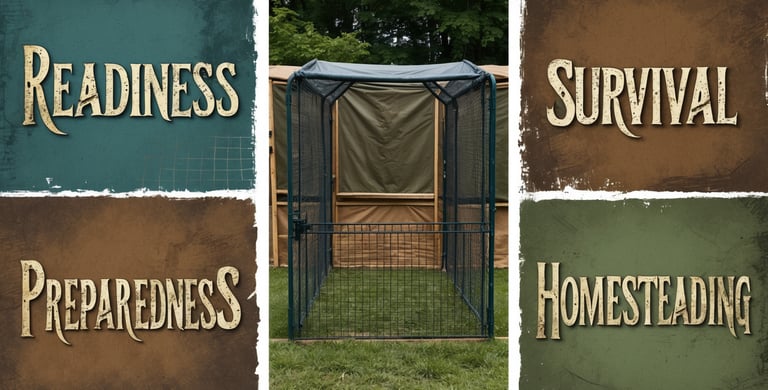Preparedness: Food Preparedness
Long-Term Storage, Shelf Life, and Nutritional Strategy
4FORTITUDER - READINESS, SURVIVAL, PREPAREDNESS, HOMESTEADING
Preparedness: Food Preparedness
Long-Term Storage, Shelf Life, and Nutritional Strategy
“He who does not provide for his own… is worse than an unbeliever.”
— 1 Timothy 5:8
Food Is Not Just Fuel—It’s Foundation
In modern comfort, food is flavor, convenience, and ritual. But in crisis, food becomes governance. Hunger alters morale, pace, and power. It turns men cruel. It cracks the strongest family.
Food preparedness is not about stacking calories—it’s about creating a strategic, sustainable system that fuels your body, protects your health, and maintains your mission under stress and scarcity.
It is the art of preparing for days when the grocery store becomes a graveyard of empty shelves and the farm trucks never come.
Core Knowledge Foundation: The Four Layers of Food Preparedness
You don’t need 1,000 cans in your basement. You need a layered food structure that addresses:
Immediate Disruption (0–3 days)
Mid-Term Sustenance (3–30 days)
Long-Term Storage (1–12 months)
Renewable Nutrition (gardens, animals, foraging)
Misconception Warning: Having food isn’t the same as being food-prepared. Without planning, knowledge, and rotation, your food becomes dead weight—or a source of disease.
1. Immediate Disruption (0–3 Days)
Goal: Zero prep, no cook, instant access. No thinking—just movement.
How to Prepare:
Shelf-stable, high-calorie items:
Protein bars (250–300 cal)
Peanut butter packets
Jerky, trail mix, dried fruit
Tuna pouches, crackers
Store in: Go-bag, car kit, hallway closet
How to Use:
Rotate every 3 months (eat + replace)
Teach family: “In an emergency, eat these first.”
Drill: Simulate a 48-hour power outage. Use only food from your grab-and-go supply. Evaluate energy levels, morale, and variety.
2. Mid-Term Sustenance (3–30 Days)
Goal: Simple, nutritious meals that sustain energy, morale, and health without refrigeration.
How to Prepare:
Bulk grains: rice, oats, quinoa
Legumes: lentils, black beans, chickpeas
Canned proteins: chicken, salmon, beef
Powdered milk, eggs, broth
Seasonings: salt, bouillon, pepper, garlic
Storage Method:
Store in cool, dry space
Use airtight bins or Mylar bags with oxygen absorbers
First In, First Out (FIFO) rotation
Cooking Without Power:
Rocket stove, propane burner, fire-safe cookware
Solar oven for daylight meal prep
Pre-mix seasoning packets for fast flavor
Drill: Plan 7 days of no-fridge meals. Cook all food using only emergency tools. Log energy use and cleanup effort.
3. Long-Term Storage (1–12 Months)
Goal: Preserve stability across economic, supply, or regional crises.
How to Prepare:
Freeze-dried meals (Mountain House, ReadyWise) – 25-year shelf life
Whole wheat berries + hand grinder
Dehydrated fruits/vegetables in vacuum-sealed bags
Home-canned goods (pressure or water-bath)
Fat sources: ghee, coconut oil, olive oil (rotate yearly)
Storage Notes:
Label each item: purchase date + expiration
Use gamma-seal lids on food-grade buckets
Keep away from light, heat, pests
Drill: Make one full meal per week using only long-term goods. Train your palate and troubleshoot storage fatigue.
4. Renewable Nutrition
Goal: Transition from stockpile to supply chain independence.
How to Implement:
Gardening:
Start with 3 vegetables per season
Use raised beds or containers if space is limited
Learn crop rotation + seed saving
Small Livestock:
Chickens = eggs + compost
Rabbits = meat + minimal space
Bees = pollination + honey
Wild Edibles & Foraging:
Dandelion, purslane, wild garlic
Basic mushroom identification (avoid unless trained)
Learn 5–10 local plants per season
Drill: Harvest, cook, and eat one meal using only what you’ve grown, caught, or stored.
Advanced Insights: Nutritional Resilience vs. Caloric Panic
Food prep isn't just about having enough—it’s about having the right kind.
Key Factors to Include:
Protein: Muscle preservation + immune support
Fat: Dense calories + hormone regulation
Fiber: Digestion + satiety
Salt: Electrolyte balance, food preservation
Vitamin-rich sources: Sprouts, stored multivitamins, preserved greens
Micro Strategy: Store a sprouting kit (alfalfa, lentil, broccoli seeds) to grow micronutrients in 3–5 days without soil.
Historical Anchor: WWII Victory Gardens
Families grew 40% of U.S. vegetables in home plots. This wasn’t survivalism—it was national-level preparedness powered by ordinary people taking responsibility for their own tables.
Critical Perspectives: The Mockery of the “Prepper Pantry”
Adversarial Viewpoint:
“Stockpiling food is selfish. Just-in-time systems keep shelves full. Don’t live in fear.”
Response:
Preparedness isn’t fear—it’s forethought in love. You stock not to hoard, but to ensure your family doesn’t go without when others panic. A prepared household is one less dependent on overwhelmed systems.
Wisdom and Warning Duality
When Followed: Your home becomes calm during chaos. Meals continue. Energy stays stable. Illness is resisted.
When Ignored: You rely on failing stores. Your family sees panic. Nutrition plummets. Morale collapses.
Strategic Crossroad: Will you feed your house with intention—or watch it hunger with regret?
Final Charge & Implementation
Brother, food preparedness is not a fringe obsession. It is a moral act. You are a provider. Your table is a covenant. Don’t wait for a truck to fail or a system to collapse before you reclaim responsibility for what goes on your plate.
Start Now:
Build Your 4-Layer Food Plan
“A stocked pantry is a silent guardian.”
3-day no-prep kit
30-day shelf meal system
1-year rotation plan
Homegrown nutrition strategy
Establish the Weekly Rotation Ritual
“Food stored is food stewarded.”
Each week: Eat one shelf meal
Re-stock what you ate
Log expiration check once/month
Teach children how to cook one “no fridge” meal
Strategic Reflection:
If your grocery store shut down tonight—how many meals could you serve, calmly, before panic set in?
Existential Challenge:
Will your family see you scrambling—or seated at a table that never went empty?
Feed your house with wisdom. Stack not fear, but provision. Prepare your pantry like your legacy depends on it—because it does.
“In famine, the wise feed. In plenty, the wise prepare.”


